
Mentuhotep II, also known under his prenomen Nebhepetre, was an ancient Egyptian pharaoh, the sixth ruler of the Eleventh Dynasty. He is credited with reuniting Egypt, thus ending the turbulent First Intermediate Period and becoming the first pharaoh of the Middle Kingdom. He reigned for 51 years, according to the Turin King List. Mentuhotep II succeeded his father Intef III on the throne and was in turn succeeded by his son Mentuhotep III.
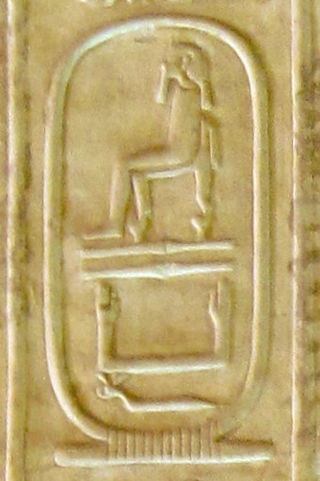
Shepseskaf was a pharaoh of ancient Egypt, the sixth and probably last ruler of the fourth dynasty during the Old Kingdom period. He reigned most probably for four but possibly up to seven years in the late 26th to mid-25th century BC.

Djedkare Isesi was a pharaoh, the eighth and penultimate ruler of the Fifth Dynasty of Egypt in the late 25th century to mid-24th century BC, during the Old Kingdom. Djedkare succeeded Menkauhor Kaiu and was in turn succeeded by Unas. His relationship to both of these pharaohs remain uncertain, although it is often conjectured that Unas was Djedkare's son, owing to the smooth transition between the two.

Ancient Egyptian art refers to art produced in ancient Egypt between the 6th millennium BC and the 4th century AD, spanning from Prehistoric Egypt until the Christianization of Roman Egypt. It includes paintings, sculptures, drawings on papyrus, faience, jewelry, ivories, architecture, and other art media. It was a conservative tradition whose style changed very little over time. Much of the surviving examples comes from tombs and monuments, giving insight into the ancient Egyptian afterlife beliefs.
In ancient Egypt, cats were represented in social and religious scenes dating as early as 1980 BC. Several ancient Egyptian deities were depicted and sculptured with cat-like heads such as Mafdet, Bastet and Sekhmet, representing justice, fertility, and power, respectively. The deity Mut was also depicted as a cat and in the company of a cat.
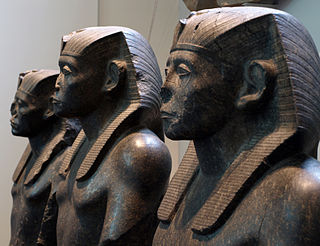
Khakaure Senusret III was a pharaoh of Egypt. He ruled from 1878 BC to 1839 BC during a time of great power and prosperity, and was the fifth king of the Twelfth Dynasty of the Middle Kingdom. He was a great pharaoh of the Twelfth Dynasty and is considered to rule at the height of the Middle Kingdom. Consequently, he is regarded as one of the sources for the legend about Sesostris. His military campaigns gave rise to an era of peace and economic prosperity that reduced the power of regional rulers and led to a revival in craftwork, trade, and urban development. Senusret III was among the few Egyptian kings who were deified and honored with a cult during their own lifetime.
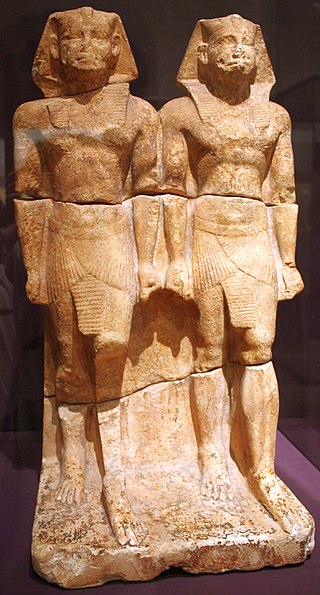
Nyuserre Ini was an Ancient Egyptian pharaoh, the sixth ruler of the Fifth Dynasty during the Old Kingdom period. He is credited with a reign of 24 to 35 years depending on the scholar, and likely lived in the second half of the 25th century BCE. Nyuserre was the younger son of Neferirkare Kakai and queen Khentkaus II, and the brother of the short-lived king Neferefre. He may have succeeded his brother directly, as indicated by much later historical sources. Alternatively, Shepseskare may have reigned between the two as advocated by Miroslav Verner, albeit only for a few weeks or months at the most. The relation of Shepseskare with Neferefre and Nyuserre remains highly uncertain. Nyuserre was in turn succeeded by Menkauhor Kaiu, who could have been his nephew and a son of Neferefre.

Abusir is the name given to an ancient Egyptian archaeological pyramid complex comprising the ruins of 4 kings' pyramids dating to the Old Kingdom period, and is part of the Pyramid Fields of the Memphis and its Necropolis UNESCO World Heritage Site.
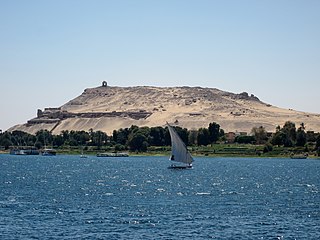
Qubbet el-Hawa or "Dome of the Wind" is a site on the western bank of the Nile, opposite Aswan, that serves as the resting place of ancient nobles and priests from the Old and Middle Kingdoms of ancient Egypt. The necropolis in use from the Fourth Dynasty of Egypt until the Roman Period.

The necropolis of Draʻ Abu el-Naga' is located on the West Bank of the Nile at Thebes, Egypt, just by the entrance of the dry bay that leads up to Deir el-Bahari and north of the necropolis of el-Assasif. The necropolis is located near the Valley of the Kings.

Heqakheperre Shoshenq II or Shoshenq IIa was a pharaoh of the Twenty-second Dynasty of Egypt. He was the only ruler of this dynasty whose tomb was not plundered by tomb robbers. His final resting place was discovered within an antechamber of Psusennes I's tomb at Tanis by Pierre Montet in 1939. Montet removed the coffin lid of Shoshenq II on March 20, 1939, in the presence of king Farouk of Egypt himself. It proved to contain many jewel-encrusted bracelets and pectorals, along with a beautiful hawkheaded silver coffin and a gold funerary mask. The facemask had been placed upon the head of the king. Montet later discovered the intact tombs of two Twenty-first Dynasty kings a year later in February and April 1940 respectively. Shoshenq II's prenomen, Heqakheperre Setepenre, means "The manifestation of Ra rules, the chosen one of Ra."
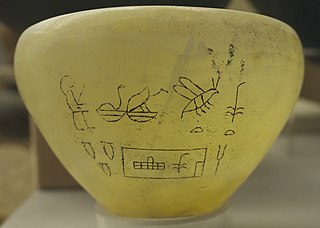
Semerkhet is the Horus name of an early Egyptian king who ruled during the First Dynasty. This ruler became known through a tragic legend handed down by the historian Manetho, who reported that a calamity of some sort occurred during Semerkhet's reign. The archaeological records seem to support the view that Semerkhet had a difficult time as king and some early archaeologists questioned the legitimacy of Semerkhet's succession to the Egyptian throne.
Kom el-Hisn is a Nile Delta settlement dating back to the Old Kingdom of Egypt with parts dating to the Middle Kingdom. Its location in the 3rd nome of Lower Egypt, or "House of the Lord of Ships ", focus on the goddess Hathor, as well as faunal and textual evidence suggests it played a role in transporting cattle between regions. Whether or not it was a self-sufficient town or built solely to support the temple is currently unknown.
The necropolis of Meir is an archaeological site in Middle Egypt in the Asyut Governorate located on the west bank of the Nile. Here are the graves of the nomarchs, mayors and priests of Cusae from the ancient Egyptian Old and Middle Kingdom.

The Tomb of Akhethetep, also known as Mastaba of Akhethetep, is a tomb complex in Saqqarah, Egypt. It was built for Akhethetep, a royal official, near the western part of the Pyramid of Djoser. Akhethetep was an official with several, mainly religious titles. including priest of Heka, priest of Khnum and priest of Horus. The tomb's decorated chapel was removed in 1903 and reassembled at the Louvre in Paris, where it is also known as the "Mastaba of Akhethetep" or simply "le mastaba du Louvre".

Raherka and Meresankh is a group statue of an ancient Egyptian couple of the 4th Dynasty or 5th Dynasty.

Wenennefer was an ancient Egyptian High Priest of Osiris at Abydos, during the reign of pharaoh Ramesses II of the 19th Dynasty.

Yuyu was an ancient Egyptian High Priest of Osiris at Abydos, during the reign of pharaohs Ramesses II and possibly Merenptah of the 19th Dynasty.
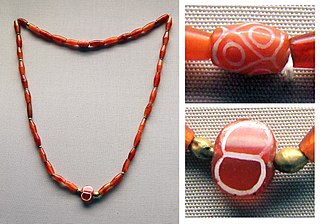
Etched carnelian beads, or sometimes bleached carnelian beads, are a type of ancient decorative beads made from carnelian with an etched design in white, which were probably manufactured by the Indus Valley civilization during the 3rd millennium BCE. They were made according to a technique of alkaline-etching developed by the Harappans, and vast quantities of these beads were found in the archaeological sites of the Indus Valley civilization. They are considered as an important marker of ancient trade between the Indus Valley, Mesopotamia and even Ancient Egypt, as these precious and unique manufactured items circulated in great numbers between these geographical areas during the 3rd millennium BCE, and have been found in numerous tomb deposits.

Iyri was an ancient Egyptian priest in the function of a High Priest of Ptah, who was in office under king Seti II in the Egyptian Nineteenth Dynasty.

















